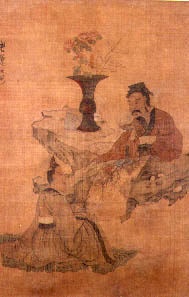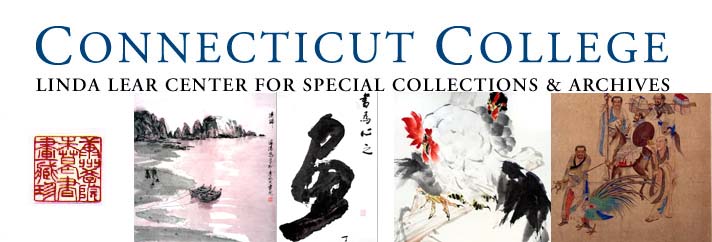Human Figure Paintings
Ch'en Hung-shou (1599 - 1652)
Viewing a Painting
Chinese Ink on Rice Paper, Framed, 25 1/4 x 16 5/8 in., (64 x 42.25 cm.)
 Ch'en Hung-shou is the dominant figure painter in the history of Chinese painting during the late Ming era in terms of popularity, quality and quantity of paintings. He is also known for his landscapes and flowers. Born to an educated family near Hangchou, the capital of Southern Sung dynasty (1127 - 1280) he was blessed with opportunities to learn how to paint early in life. At the age of four he painted the God of War on paper four feet tall. At nineteen he illustrated the famous story ascribed to Ch'u Yuan , ca. 340 - 290 bce, "Nine Songs." (See THE DISTANT MOUNTAINS, James Cahill, p 246) Refined and sophisticated linear drawing marked his figures throughout his career.
Ch'en Hung-shou is the dominant figure painter in the history of Chinese painting during the late Ming era in terms of popularity, quality and quantity of paintings. He is also known for his landscapes and flowers. Born to an educated family near Hangchou, the capital of Southern Sung dynasty (1127 - 1280) he was blessed with opportunities to learn how to paint early in life. At the age of four he painted the God of War on paper four feet tall. At nineteen he illustrated the famous story ascribed to Ch'u Yuan , ca. 340 - 290 bce, "Nine Songs." (See THE DISTANT MOUNTAINS, James Cahill, p 246) Refined and sophisticated linear drawing marked his figures throughout his career.
He acquired painting skills by imitating extant paintings from T'ang and Sung times. These are line drawings, with or without slight color. Ch'en Hung-shou and his contemporaries played the most important role in reviving figure painting after it had been in decline for over three hundred years.
As Ch'en's popularity grew he continued to illustrate famous legends, stories and Ming novels such as STORIES OF THE WESTERN CHAMBER and STORIES OF WATER MARGIN. Both books are available today. He even created "Water Margin" playing cards with different images of bandits and episodes from the book for popular consumption. It is not possible to date these cards precisely, but it is likely that he was in his late thirties-a time when he was compelled to sell paintings. Ch'en wanted to be in politics, as were his grandfather and father, but failed imperial examinations. Although he wished to belong to the elite class and did not like to be considered a professional painter, he sometimes found those "illustrious gentlemen" to be dilettantes, dabblers.
When the Ching army overthrew the Ming dynasty in 1644, Ch'en was put into prison and later dispatched to his native place. He often regretted that he survived because a number of his friends had sacrificed their lives defending the Ming Dynasty. He felt ashamed and called himself Hui Ch'ih "Repent late." Our piece was signed with this new name. During the eight years after the fall of Ming and before he died Ch'en Hung-shou painted bizarre, exaggerated figures with elongated heads and serious faces, reflecting his own inner mood and character, marking a clearly definable style. His influence is still seen among contemporary painters.
This painting was purchased with funds provided by Mr. and Mrs. Harold Pratt of Cambridge, Massachusetts. Frances Pratt is an alumna and former trustee of the college.
